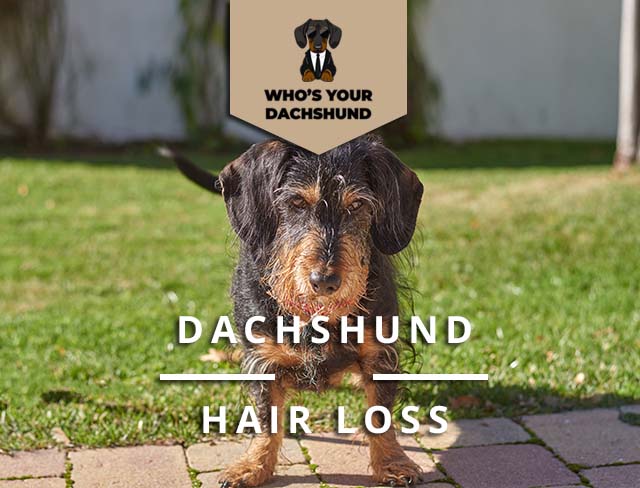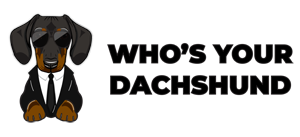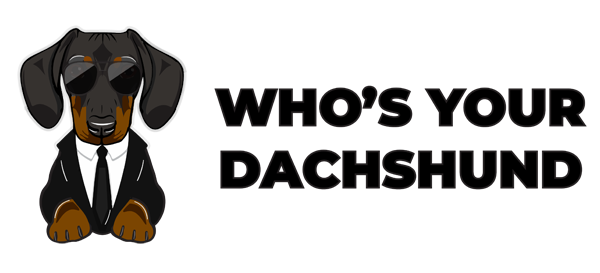
Dachshund hair loss is a common condition in dachshunds where they lose their fur, particularly on the back end. The causes of dachshund hair loss are not always clear. One of the primary causes of dachshund hair loss is seasonal.
But dachshunds can also have this condition due to inflammation and infections in their skin, or even over-grooming. Understanding how to detect the effects of dachshund hair loss will help you understand what needs to be done to fix it and why they have this problem.
Dachshunds can experience various hair loss problems, including dandruff, shedding, and balding. These are prevalent conditions in dogs; many dachshund owners have seen their pets losing hair or displaying these symptoms from time to time. While we don’t know which factors cause dachshunds to lose fur, a combination of factors is likely contributing to this issue.
Various causes of dachshund hair loss can often lead to secondary infections that cause even more severe problems. And while we don’t want to scare you by saying that dachshunds can die from this condition, it’s true. As such, it’s essential to recognize the signs and symptoms as soon as possible so that you can act appropriately for your pet.
Why Is My Dachshund’s Hair Falling Out?
Some dogs’ hair falls out in the winter, but this is not the case for all dogs. However, your pup may be experiencing some form of stress or anxiety, which manifests as hair loss. Symptoms of these are:
- Dachshund is constantly itching.
- Very small or no appetite.
- Bloating, diarrhea or vomiting after eating.
- Lethargy, depression, loss of energy/interest in usual activities, and people they love to play with/be around
- Dachshund could have stuffed up nostrils, and their nose may be dry and crusty, possibly smelling bad (like burnt rubber).
- Dachshund may be hunching or walking around with their tail between their legs (depressed).
- Barking and whining a lot and making weird noises.
- Runny/red eyes, swollen or dry eyes, or itchy eyes.
- Unexplained weight loss/weight gain (more than 5% within one month).
- Excessive shedding
Does Dachshund Hair Grow Back?
Whether or not dachshund hair grows back is a popular one. The answer? Yes, but it may take some time.
Dachshunds are known for their long and thin bodies. That’s because dachshund hair is so fine. Their hair grows from head to toe rather than toe to head compared to the other animals. That makes sense when you consider Dachshund’s original purpose of hunting burrowing animals, such as badgers, martens, and foxes.
Dachshunds do shed their coats about once or twice a year. It’s important to note that dachshunds do not shed their entire coat as cats and dogs do.
Only the topcoat or outer hair is shed. The undercoat or softer hair does not fall out. This softer hair grows back, and it will produce the classic dachshund curls that people love to see in their pets.
Common Causes on Dachshund Hair Loss
There are several reasons for dachshund hair loss, and it can be troublesome to diagnose the specific cause. Some of the most common hair loss reasons for dachshunds are:
Flea Allergy Dermatitis
“Flea Allergy Dermatitis” is a general term for the skin reactions to flea bites resulting in an inflamed, itchy, and sometimes oozy rash. “Flea Allergy Dermatitis” is caused by a reaction to the flea’s saliva. The saliva gets rubbed into the skin with flea’s movement and is very irritating and itchy.
Atopy
Atopy, also called atopic dermatitis, is a type of eczema. Atopic dermatitis causes dry skin and is often itchy. It usually affects the knees’ areas, on the elbows, and in front of the ears and eyes. Atopy causes intensely itchy skin, so much so that there are times when you feel as if you will go crazy because of the itching. Dachshunds are easily susceptible to this type of eczema due to a genetic predisposition.
Central Nervous System (Cns) Tumors
Central nervous system tumors, such as meningiomas and lymphocytic leukemia, develop from cells in the brain or spinal cord. Meningiomas are typically benign and slow-growing, while lymphocytic leukemia invades the skin, growing and spreading.
Hypothyroidism
Dachshunds are predisposed to hypothyroidism because of their popularity as pets. Hypothyroidism is often referred to as an underactive thyroid. It causes the body to produce too little thyroid hormone. The result is low energy, decreased metabolism, and weight gain isn’t constant or healthy. Your pet’s coat can become dry and thin due to the decrease in hormones, causing hair loss.
Wart Virus
Dachshunds are naturally susceptible to Wart Virus, also known as canine papillomavirus. The virus typically infects the skin resulting in a wart on the dog’s footpad. It can spread rapidly to other body areas, especially to the feet and head, causing hair loss.
Diabetes mellitus
Diabetes is controlled through insulin injections that regulate glucose metabolism in the body. This type of hair loss in a dog occurs at the skin or mucous membranes such as the eyes. The hair loss is usually seen only in the area where insulin and sugar levels are high, i.e., on the lower legs or the back.
Fungal Infections
“Fungal infections” is a term for several different types of fungal skin disease, including ringworm (a type of dermatitis), mites and head lice, ringworm (atopic dermatitis), and warts (parasitic). Fungal infections are common among dachshunds and can cause hair loss.
Dachshunds often have a very thick undercoat that can hide hair loss signs. They also have tight skin folds around their neck, making it challenging to see bald patches and patches with thinning hair.
Treatment Options If You Think Your Dog Has Dachshund Hair Loss
The first step in treating the hair loss problem in a dachshund is to have the dog examined by a vet to determine any specific health issues. Once the veterinarian determines that there is no medical reason for the hair loss, you may want to consider some at-home treatment methods.
As with any other type of dog hair loss, you will want to start by making sure you are brushing your dog regularly. It will help remove dead and loose hair and reduce shedding on your furniture and clothing. Ensure that you are also using dog shampoo on your Dachshund’s coat. The shampoo should have moisturizing ingredients, which will help keep the skin healthy.
You also want to make sure that you are giving your dog plenty of exercises daily. When dachshunds feel healthy and happy, they tend to have more energy, and it shows in their coat. Playing will also help release excess energy that may cause your Dachshund stress and anxiety, which can cause hair loss.
Hair Loss in Dachshunds; What’s Normal?
Hair loss in Dachshunds is common, and most cases are considered normal. The only abnormal hair loss that has been found in Dachshunds is that which occurs in the skin that makes up the ear canal.
What’s Normal?
While typical alopecia (hair loss) can occur at any time, it most commonly appears between 6 and 18 months of age and seems restricted to one or two locations on the body. The body hair is replaced by a downy growth of hair called lanugo hair, which sheds in equally distributed patches as regular coat regrowth begins.
Typically, only a few areas are affected, but it is not unusual for all of a Dachshund’s coat to be lost at one time. This extensive shedding usually lasts less than two weeks and involves every aspect of the dog’s coat (including whiskers).
The hair starts falling again at the same rate as it did before, and regrowth occurs in the same place it did before. At this point, it may or may not look normal. It depends on how much remains and how much is lost. It is necessary to remember that the hair loss does not change the Dachshund’s appearance in any way.
Average hair loss in Dachshunds does not affect other parts of the dog’s anatomy (such as eyes), nor does it cause any problems with temperament or health. Most cases are considered normal, and no special treatment is needed except for a low dose of monthly flea control medication.
Why Losing Hair on Her Back Occurs in Dogs
The reason why some dogs bald on their backs is due to a condition called Alopecia X (or Alopecia Universalis). It is a hair loss issue that affects all breeds. Alopecia X’s cause is unknown, and there is no known cure. Different factors cause different types of Alopecia X, but the two most common are Alopecia X Congenital (hereditary) and idiopathic (no known cause).
Prevention of Losing Hair on Her Back
To prevent hair loss on the back of her head, she needs to spend a lot of time every day brushing and combing her hair. Regular visits to the hairdresser will help remove any tangles from the brush. Then she needs to condition her hair and apply a coat of non-toxic dog shampoos. Wrapping her coat with a towel before she goes out will help eliminate the moisture in her hair that causes tangles. She also needs to be careful not to overheat when she goes out (don’t leave the AC on and forget to bring an extra sweater), watch for signs of overheating (e.g., rapid panting, looking flushed), and get immediate veterinary assistance if necessary. If your dog falls in the cold water, take action immediately by putting ice packs on the area and then rushing her to your veterinarian for immediate veterinary care.

